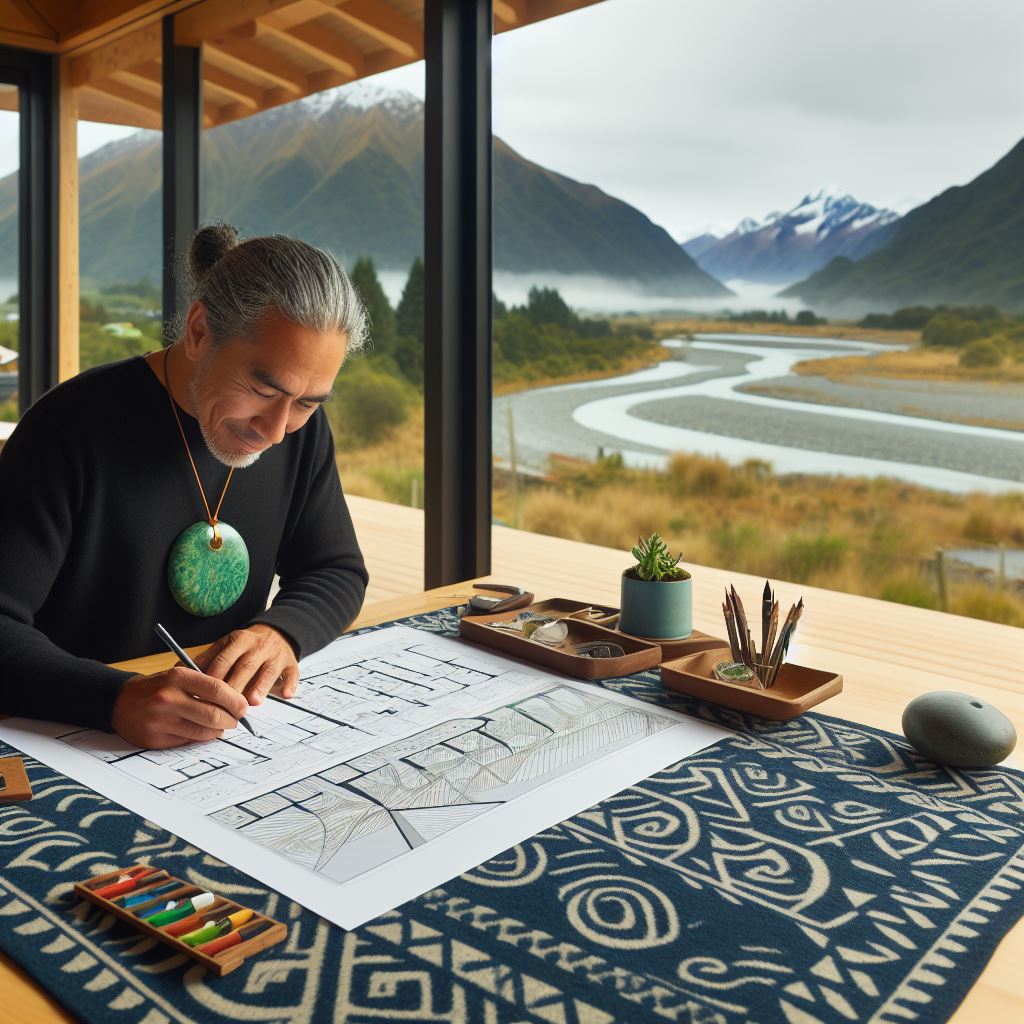Introduction
Exploring architectural design technology in New Zealand reveals a dynamic landscape of innovation and sustainability.
Architects leverage cutting-edge tools and techniques to shape the built environment, driving progress and addressing contemporary challenges.
From advanced software applications to sustainable building materials, the field continually evolves, offering endless possibilities.
Architects play a pivotal role in integrating these advancements into their design processes, fostering collaboration and efficiency.
They utilize tools like parametric modeling and Building Information Modeling (BIM) to create intricate designs and streamline workflows.
By embracing technology, architects in New Zealand can meet the demands of modern construction projects while minimizing environmental impact.
Moreover, staying informed about emerging trends and innovations is crucial for architects to remain competitive in the industry.
Sustainable practices and digital tools enable professionals to navigate complex projects with ease, contributing to the creation of resilient and eco-friendly structures.
In summary, exploring architectural design technology in New Zealand unveils a dynamic landscape ripe with opportunities for innovation and sustainability.
By embracing digital tools and sustainable practices, architects can shape a brighter future for the built environment in New Zealand and beyond.
History of Architectural Design Tech in NZ
In this section, we will explore the rich history of architectural design technology in New Zealand.
We will discuss the early architectural design techniques, the evolution and development over the years, as well as notable architectural designs in NZ.
Let’s dive in!
Overview of early architectural design techniques
- Maori Architecture: The indigenous Maori people of New Zealand had a unique architectural style, using natural materials such as timber, flax, and stones, and incorporating intricate carvings and decorations.
- Colonial Influence: With the arrival of European settlers in the 19th century, architectural styles started to shift towards European influences. Victorian and Gothic Revival styles became popular, with ornate detailing and grandeur.
- Art Deco: In the 20th century, New Zealand embraced the Art Deco movement, characterized by geometric shapes, bold colors, and streamlined designs. This style is still prominent in cities like Napier.
Evolution and development over the years
- Modernism: After World War II, New Zealand experienced a shift towards modernist architectural designs. This style emphasized functionality, simplicity, and clean lines, with architects like Ernst Plischke leading the way.
- Postmodernism: In the 1980s and 1990s, postmodernism gained popularity in New Zealand. Architects started to experiment with shapes, materials, and forms, creating unique and playful designs.
- Sustainable Design: With the growing concern for the environment, sustainable design became a prominent aspect of architectural design tech in NZ. Green building practices and energy-efficient designs started to take center stage.
Notable architectural designs in NZ
- Sky Tower: The iconic Sky Tower in Auckland is not only a telecommunications tower but also a stunning architectural marvel, offering panoramic views of the city.
- Beehive: Located in Wellington, the Beehive is the distinct executive wing of the New Zealand Parliament Buildings, known for its unique circular design and striking appearance.
- Te Papa Tongarewa: The national museum of New Zealand in Wellington is a remarkable architectural masterpiece, housing a vast collection of cultural and natural artifacts.
- Hobbiton: While not a traditional architectural design, the movie set of Hobbiton in Matamata showcases the beautiful and intricate craftsmanship that went into creating the fictional world of Middle-earth.
- Christchurch Cathedral: The Christchurch Cathedral, prior to its destruction in the 2011 earthquake, was a stunning example of Neo-Gothic architecture, attracting visitors from around the world.
Basically, the architectural design tech in New Zealand has a diverse and fascinating history.
From the Maori influences to the modernist and postmodernist movements, the architectural landscape of NZ is a testament to creativity and innovation.
With a focus on sustainability and unique designs, New Zealand continues to push the boundaries of architectural excellence.
Read: The Future of Electrical Engineering in NZ
Current Trends in Architectural Design Tech in NZ
Sustainable and Eco-friendly Designs
- Emphasis on sustainable and eco-friendly designs has become a significant trend in architectural design tech in NZ.
- Architects are incorporating environmentally conscious materials and energy-efficient systems in their designs.
- The use of renewable energy sources such as solar panels and wind turbines is increasing.
- Buildings are designed to optimize natural lighting and ventilation, reducing the need for artificial energy consumption.
- Green roofs, vertical gardens, and rainwater harvesting systems are commonly integrated into architectural designs.
Integration of Technology in Design and Construction
- Technology continues to play a crucial role in architectural design and construction processes in NZ.
- Computer-aided design (CAD) software enables architects to create precise and detailed designs.
- Building Information Modeling (BIM) allows for the creation of virtual 3D models, enhancing collaboration and communication among stakeholders.
- Advanced construction techniques such as prefabrication and modular construction are being embraced.
- Robotics and automation are utilized in construction processes, improving efficiency and productivity.
Incorporation of Cultural Elements in Architectural Designs
- NZ architectural designs are increasingly incorporating cultural elements to celebrate the country’s diverse heritage.
- Indigenous Maori design principles are being integrated, emphasizing spiritual and cultural values.
- The use of traditional materials like timber and earth in contemporary designs reflects the connection to the land.
- Cultural symbols and motifs are incorporated into building facades, interior spaces, and public art.
- Community engagement and consultation are prioritized to ensure architectural designs respect and represent local cultures.
The architectural design tech in NZ is evolving to embrace sustainable practices, technological advancements, and cultural integration.
Architects are designing buildings that are not only aesthetically pleasing but also environmentally friendly.
Integration of technology improves design precision and construction efficiency.
Cultural elements in architectural designs celebrate NZ’s diverse heritage and create a sense of belonging.
These current trends in architectural design tech contribute to the overall progress and development of the industry in NZ.
Read: NZ Electrical Engineering: Industry Insights
Prominent Architectural Design Tech Companies in NZ
Introduction to leading companies in the field
New Zealand’s architectural design tech industry is home to several leading companies that have made significant contributions to the field.
These companies have played a crucial role in shaping the built environment and have demonstrated excellence through their innovative and sustainable designs.
One of the prominent companies in the industry is Tierra Architects.
Established in 2005, Tierra Architects focuses on creating sustainable and aesthetically pleasing structures.
They are known for their commitment to environmental stewardship and have won numerous awards for their green designs.
Tierra Architects takes a holistic approach to design, considering factors such as energy efficiency and the use of eco-friendly materials.
Another notable player in the industry is Draw Tech Design Group.
With over two decades of experience, Draw Tech Design Group has established themselves as one of the leading architectural design tech companies in NZ.
They specialize in creating functional spaces that address the needs of their clients while also incorporating innovative design solutions.
Draw Tech Design Group has worked on a wide range of projects, including residential, commercial, and public spaces.
Personalized Career Consulting
Unlock your potential with expert career advice tailored to your goals. Get personalized guidance and actionable steps toward your dream career in New Zealand.
Get StartedProfiles and notable projects of each company
Tierra Architects
Established in 2005, Tierra Architects is a renowned architectural design tech company in NZ.
Notable Projects:
- Sky Tower Redevelopment: Tierra Architects played a key role in the redevelopment of Auckland’s iconic Sky Tower. Their design focused on enhancing the visitor experience while ensuring sustainability.
- Green Office Park: Tierra Architects designed a state-of-the-art green office park in Wellington. The park incorporates energy-efficient systems, green spaces, and sustainable materials.
Draw Tech Design Group
With over two decades of experience, Draw Tech Design Group has a strong presence in the architectural industry.
Notable Projects:
- City Hall Renovation: Draw Tech Design Group was responsible for the renovation and modernization of Wellington’s City Hall. Their design successfully preserved the building’s historic charm while incorporating contemporary elements.
- Sustainable Housing Development: Draw Tech Design Group designed a sustainable housing development in Christchurch. The project focused on energy efficiency, affordability, and community engagement.
Jasmax Architects
Jasmax Architects is a multidisciplinary design firm known for their innovative approaches.
Notable Projects:
- Te Papa Museum Expansion: Jasmax Architects led the expansion project of Te Papa, New Zealand’s national museum. Their design seamlessly integrated new spaces with existing structures, creating a cohesive and visually striking museum experience.
- University of Otago School of Medicine: Jasmax Architects designed a state-of-the-art facility for the University of Otago’s School of Medicine. The building incorporates cutting-edge technology and flexible learning spaces.
These are just a few examples of the many prominent architectural design tech companies in NZ.
Each company brings a unique perspective and expertise to the field, contributing to the vibrant architectural landscape of New Zealand.
Read: Essential Skills for NZ’s Electrical Engineers

Architectural Design Education and Training in NZ
Overview of architectural design programs in universities
In New Zealand, universities offer comprehensive architectural design programs to students interested in the field.
These programs provide a solid foundation in various aspects of architecture, including design principles, construction methods, and sustainability.
Students learn to develop innovative and practical solutions for buildings, considering factors such as aesthetics, functionality, and environmental impact.
Additionally, the programs incorporate theoretical and historical knowledge to ensure a well-rounded education.
Universities in NZ emphasize studio-based learning, where students engage in hands-on design projects to hone their skills.
Through these programs, aspiring architects gain the necessary expertise to excel in the industry.
Professional training opportunities and certifications
Aside from university programs, there are various professional training opportunities available for architectural design enthusiasts in NZ.
One such opportunity is the New Zealand Registered Architects Board (NZRAB) Architectural Graduates Program.
This program allows graduates to work under the supervision of a registered architect while completing their training requirements.
It provides practical experience in various architectural firms and helps graduates develop their skills and knowledge further.
Another essential aspect of professional training in NZ is the pathway to becoming a registered architect.
This program focuses on the technical understanding of architectural design.
Furthermore, graduates need to complete a minimum of two years of practical work experience and pass the NZRAB examination.
Being a registered architect in NZ ensures that architects meet the professional standards and ethical responsibilities of the field.
Continual professional development is also critical for architects to stay up to date with the latest trends and advancements in architectural design.
Architects in NZ can pursue further certifications and specialist training to enhance their skills and career prospects.
These certifications include the Green Star Accredited Professional Certification and the New Zealand Institute of Architects (NZIA) Practice of Architecture Learning Programs.
These programs provide architects with advanced knowledge in sustainable design and architectural practice management.
In fact, architectural design education and training in NZ provide students and aspiring architects with a comprehensive understanding of the field.
Universities offer programs that cover a wide range of topics, allowing students to develop their design skills and knowledge.
Professional training opportunities, such as the NZRAB Architectural Graduates Program, offer practical experience and mentorship.
Additionally, the path to becoming a registered architect ensures that professionals meet the industry’s standards and ethics.
Continual professional development through certifications and specialist training further enhances architects’ skills and career prospects.
Read: Interview: NZ Electrical Engineers’ Success Stories
Exploring Architectural Design Tech in Different Regions of NZ
Auckland
- Auckland, the largest city in New Zealand, boasts a diverse architectural landscape.
- The city’s skyline is dominated by modern skyscrapers, showcasing the latest architectural design technology.
- Auckland’s architectural gems include the iconic Sky Tower and the Auckland Art Gallery Toi o Tāmaki.
- The use of sustainable materials and energy-efficient technologies is prevalent in many new buildings.
- Innovations such as smart home automation and green roofs are becoming increasingly popular in Auckland.
Wellington
- Wellington, the capital city of New Zealand, has a unique architectural charm.
- The city’s hilly terrain often necessitates innovative design solutions for building foundations.
- Wellington embraces a mix of heritage buildings and contemporary architectural designs.
- The famous Wellington Cable Car and the Beehive are notable architectural landmarks.
- Seismic resilience is a crucial consideration in Wellington’s architectural design due to its location in an earthquake-prone zone.
Christchurch
- Christchurch, known as the ‘Garden City,’ has witnessed a significant architectural transformation in recent years.
- The rebuilding efforts following the devastating 2011 earthquake led to innovative architectural approaches.
- The Christchurch Cathedral restoration project showcases a blend of heritage preservation and modern design technology.
- The city’s new buildings are designed with earthquake-resistant features and sustainability in mind.
- The Christchurch Art Gallery Te Puna o Waiwhetū is a prime example of contemporary architectural excellence.
Other regions with significant architectural developments
- Queenstown, a popular tourist destination, combines breathtaking natural landscapes with unique architectural designs.
- The town’s luxury resorts and private residences showcase cutting-edge design and integrate seamlessly with the surroundings.
- Dunedin, with its rich Scottish heritage, features stunning Gothic Revival architecture in buildings such as the Dunedin Railway Station.
- The Hawke’s Bay region is known for its Art Deco buildings, which were primarily constructed after the devastating 1931 earthquake.
- Napier, the main city in Hawke’s Bay, attracts architecture enthusiasts with its well-preserved Art Deco structures.
In review New Zealand offers a captivating journey through architectural design technology across various regions.
From Auckland’s modern skyline to Wellington’s unique terrain-based designs, each city has its own architectural identity.
Christchurch’s post-earthquake redevelopment demonstrates resilience and innovation.
Additionally, other regions like Queenstown, Dunedin, and Hawke’s Bay contribute their own architectural significance to the country’s diverse landscape.
Exploring these architectural marvels in different New Zealand regions is a delight for both design enthusiasts and tourists alike.
Challenges and Opportunities in Architectural Design Tech in NZ
Sustainability and Climate Change Considerations
- New Zealand faces significant challenges in architectural design tech when it comes to sustainability and climate change.
- The increasing global temperature and rising sea levels present a threat to coastal cities and require innovative design solutions.
- Architects must consider sustainable materials, energy-efficient designs, and renewable energy sources to mitigate climate change impacts.
- The challenge lies in balancing modern design aesthetics with sustainable practices to create buildings that are both functional and environmentally friendly.
- By embracing sustainable architectural design tech, New Zealand can minimize its carbon footprint and contribute to a greener future.
Urban Planning and Affordable Housing Challenges
- Urban planning is a crucial aspect of architectural design tech in NZ, especially due to the increasing population and limited land availability.
- Architects face the challenge of designing buildings that meet the needs of a growing population while maintaining the integrity of urban spaces.
- Affordable housing is another pressing issue, and architects must find innovative ways to create affordable and sustainable housing options.
- Compact housing designs, mixed-use developments, and adaptive reuse of existing structures are some strategies to address the housing challenges.
- The opportunity lies in designing communities that prioritize livability, accessibility, and affordability, ensuring a high quality of life for the residents.
Collaboration and Innovation Opportunities
- Collaboration and innovation play significant roles in advancing architectural design tech in NZ.
- Architects, engineers, urban planners, and policymakers must work together to create innovative solutions for complex design challenges.
- Embracing advanced technologies like Building Information Modeling (BIM) and virtual reality allows for better visualization and efficient design processes.
- New Zealand encourages interdisciplinary collaborations, bringing together professionals from various fields to promote holistic design approaches.
- The opportunity lies in fostering a culture of innovation by supporting research and development, inspiring creativity, and promoting knowledge-sharing.
All in all, architectural design tech in NZ faces challenges related to sustainability and climate change considerations, urban planning and affordable housing, but also presents numerous collaboration and innovation opportunities.
By prioritizing sustainable practices, designing livable urban spaces, and embracing interdisciplinary collaborations, New Zealand can pave the way for a future that combines architectural beauty with environmental consciousness.
Conclusion
Exploring architectural design technology in New Zealand is essential for driving innovation and sustainability within the industry.
By delving deeper into this topic, readers can uncover the myriad possibilities and advancements shaping architectural practices in the country.
From cutting-edge software applications to sustainable building materials, the landscape of architectural design technology is continuously evolving to meet the demands of modern construction projects.
Architects play a pivotal role in integrating these technological advancements into their design processes, ultimately shaping the built environment and contributing to the overall development of cities and communities.
Whether it’s incorporating parametric modeling techniques for complex geometries or utilizing Building Information Modeling (BIM) for enhanced collaboration and efficiency, architects leverage technology to streamline workflows and deliver exceptional designs.
Furthermore, staying abreast of the latest trends and innovations in architectural design technology enables professionals to remain competitive in the industry and address contemporary challenges such as climate change and urbanization.
By embracing sustainable practices and harnessing the power of digital tools, architects in New Zealand can create environmentally conscious and aesthetically pleasing structures that enrich the built environment for generations to come.




